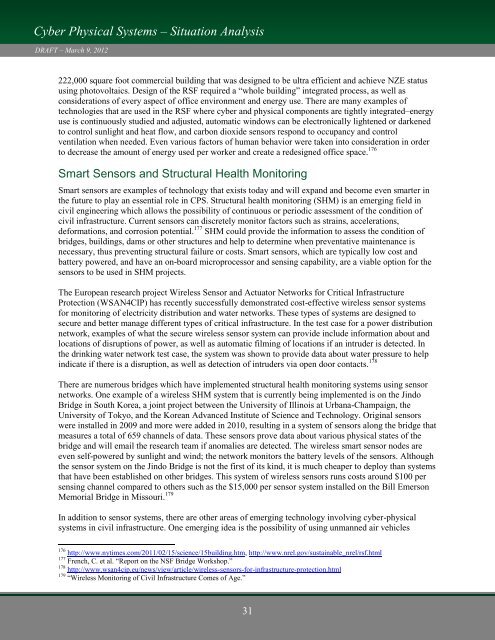Cyber Physical Systems â Situation Analysis - Energetics Meetings ...
Cyber Physical Systems â Situation Analysis - Energetics Meetings ...
Cyber Physical Systems â Situation Analysis - Energetics Meetings ...
- No tags were found...
You also want an ePaper? Increase the reach of your titles
YUMPU automatically turns print PDFs into web optimized ePapers that Google loves.
<strong>Cyber</strong> <strong>Physical</strong> <strong>Systems</strong> – <strong>Situation</strong> <strong>Analysis</strong>DRAFT – March 9, 2012222,000 square foot commercial building that was designed to be ultra efficient and achieve NZE statususing photovoltaics. Design of the RSF required a ―whole building‖ integrated process, as well asconsiderations of every aspect of office environment and energy use. There are many examples oftechnologies that are used in the RSF where cyber and physical components are tightly integrated–energyuse is continuously studied and adjusted, automatic windows can be electronically lightened or darkenedto control sunlight and heat flow, and carbon dioxide sensors respond to occupancy and controlventilation when needed. Even various factors of human behavior were taken into consideration in orderto decrease the amount of energy used per worker and create a redesigned office space. 176Smart Sensors and Structural Health MonitoringSmart sensors are examples of technology that exists today and will expand and become even smarter inthe future to play an essential role in CPS. Structural health monitoring (SHM) is an emerging field incivil engineering which allows the possibility of continuous or periodic assessment of the condition ofcivil infrastructure. Current sensors can discretely monitor factors such as strains, accelerations,deformations, and corrosion potential. 177 SHM could provide the information to assess the condition ofbridges, buildings, dams or other structures and help to determine when preventative maintenance isnecessary, thus preventing structural failure or costs. Smart sensors, which are typically low cost andbattery powered, and have an on-board microprocessor and sensing capability, are a viable option for thesensors to be used in SHM projects.The European research project Wireless Sensor and Actuator Networks for Critical InfrastructureProtection (WSAN4CIP) has recently successfully demonstrated cost-effective wireless sensor systemsfor monitoring of electricity distribution and water networks. These types of systems are designed tosecure and better manage different types of critical infrastructure. In the test case for a power distributionnetwork, examples of what the secure wireless sensor system can provide include information about andlocations of disruptions of power, as well as automatic filming of locations if an intruder is detected. Inthe drinking water network test case, the system was shown to provide data about water pressure to helpindicate if there is a disruption, as well as detection of intruders via open door contacts. 178There are numerous bridges which have implemented structural health monitoring systems using sensornetworks. One example of a wireless SHM system that is currently being implemented is on the JindoBridge in South Korea, a joint project between the University of Illinois at Urbana-Champaign, theUniversity of Tokyo, and the Korean Advanced Institute of Science and Technology. Original sensorswere installed in 2009 and more were added in 2010, resulting in a system of sensors along the bridge thatmeasures a total of 659 channels of data. These sensors prove data about various physical states of thebridge and will email the research team if anomalies are detected. The wireless smart sensor nodes areeven self-powered by sunlight and wind; the network monitors the battery levels of the sensors. Althoughthe sensor system on the Jindo Bridge is not the first of its kind, it is much cheaper to deploy than systemsthat have been established on other bridges. This system of wireless sensors runs costs around $100 persensing channel compared to others such as the $15,000 per sensor system installed on the Bill EmersonMemorial Bridge in Missouri. 179In addition to sensor systems, there are other areas of emerging technology involving cyber-physicalsystems in civil infrastructure. One emerging idea is the possibility of using unmanned air vehicles176 http://www.nytimes.com/2011/02/15/science/15building.htm, http://www.nrel.gov/sustainable_nrel/rsf.html177 French, C. et al. ―Report on the NSF Bridge Workshop.‖178 http://www.wsan4cip.eu/news/view/article/wireless-sensors-for-infrastructure-protection.html179 ―Wireless Monitoring of Civil Infrastructure Comes of Age.‖31
















